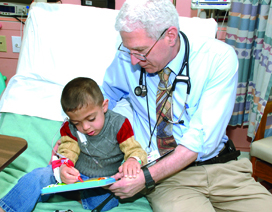
By Steve Tokar
It was a diagnosis that was no less devastating for being extremely rare: halfway around the world, a couple learned that their baby had mucopolysaccharidosis (MPS) type VI—a disease affecting roughly two thousand people on the planet.
Left untreated, the child would face a life complicated by abnormal skeletal development, movement limitations, heart valve malfunction, lung disease, vision problems, hearing abnormalities, and likely die before reaching adulthood.
Meanwhile, at Children’s Hospital and Research Center Oakland, Paul Harmatz, MD, Associate Director of Pediatric Clinical Research Center, was recruiting patients worldwide for a clinical trial of Naglazyme (also known as Galsulfase), a therapy for MPS VI developed by BioMarin Pharmaceutical Inc. in northern California.
The child met the criteria for the trial, designed to test the safety and effectiveness of starting the drug in infancy. Today, five years later, he has passed his walking, growth, and vision tests, and continues to receive weekly infusions of Naglazyme, which has now been approved for use by the FDA.
MPS in its various forms—there are seven types altogether—is one of a number of so-called lysosomal storage diseases (LSDs). “These diseases are genetic,” Harmatz explains. “An enzyme is missing that normally enables cells to break down stored material that has accumulated in the lysosome,” a sort of cellular recycling center.
Individually, these lysosomal storage diseases occur rarely, but as a group, they affect about one in 5,000 to one in 10,000 people—or about the same rate as cystic fibrosis, according to Harmatz. Treatment often involves replacing the missing enzyme with a manufactured enzyme that is given intravenously.
Enzyme replacement “has been very successful” for some MPS diseases, according to Harmatz, “filling a critical gap between no therapy at all and gene therapy that may be available someday.”
“The earlier in a patient’s life that treatment is started, the more effective it is and the identification of affected infants by newborn screening will be key. Although we’re not yet able to treat some of the skeletal abnormalities as effectively if we start late, we still see significant improvements in growth, endurance, joint range of motion, and respiratory function.”
Harmatz notes that Children’s Hospital & Research Center Oakland has become a leading institution in clinical trials of MPS medications. Presently, the hospital is involved in 7 MPS-related clinical trials.
“Many of these studies are challenging, as the patients receive the experimental therapy during a six- to seven-hour infusion every week over one to two years,” says Harmatz.
“Some patients and families must travel across the country to receive the therapy. These logistical burdens would be difficult to address without the support of the Clinical Research Services” offered through UCSF’s Clinical and Translational Science Institute (CTSI).
CTSI is a member of the National Institutes of Health-funded Clinical and Translational Science Awards (CTSA) network focusing on accelerating research to improve health. The Institute provides services for researchers at every stage, and promotes online collaboration and networking through UCSF Profiles.
